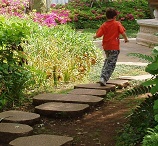 When you create a new path or outdoor living area, there is no reason to restrict yourself to just one type of paver. Combining different types of pavers or paving materials together can create contrasting and interesting effects.
When you create a new path or outdoor living area, there is no reason to restrict yourself to just one type of paver. Combining different types of pavers or paving materials together can create contrasting and interesting effects.
WHY USE MORE THAN ONE PAVING MATERIAL?
- It creates a more interesting surface to look at and walk on.
- You can blend the paved area with the house or other parts of the garden.
- It can be more functional (loose paving can be prevented from “walking”).
- You can reduce the cost of paving a large area by incorporating a cheaper material in the design.
DIVIDE UP THE PAVING
A plain concrete or asphalt path can be improved by including bricks in the design. For example, the edge of the path can be trimmed with a line of bricks or a row of tiles on each side. Alternatively, you can divide a long stretch of paving into sections by periodically crossing the path with a row of bricks or tiles.
Another option is use large paving slabs interspersed with smaller paving modules. These divisions can be made between each large paver or between every second or third paver. It will depend upon the effect you wish to create and the size of the paved area. This sort of approach is suitable for wide paths and patio areas.
Interspersing cobblestones with sections of pavers is another way to create interest in a paved area.
WHAT IS A ‘MODULE’?
A module is a term used to describe an individual paving unit. Some brick and concrete pavers are specifically made so that they can be tightly interlocked. Other paving materials, such as cobblestones and slate, come in irregular module shapes and require mortar to join them together with other materials.
TIMBER PAVING
Timber is another material that can be used to improve the appearance of a paved area. It can be used as an edging material, or to create interest by breaking up a long path or large paved area. You should carefully consider how you are going to include timber in your paving design, as it will be less durable than bricks, concrete or asphalt.
SAME MATERIAL – TWO COLOURS
You don’t have to use different materials to create a two-tone effect in your paving design. By using two different colours of brick or concrete pavers, you can create exciting design patterns that will liven up the landscape. Options include alternating colours or dividing up the area with paving modules of a different colour.
The advantage of this approach is that it’s easy to construct, and all the pavers will wear and react to changes in temperature in the same way.
 WHAT PATTERN?
WHAT PATTERN?
- Different paving patterns create different effects.
- Lines extending away from they eye make the area look longer and narrower.
- Lines that cross the line of view make the area seem wider and not as deep.
- Circular patterns draw the eye to the centre of the area.
COLOURED CONCRETE
- Concrete is no longer the boring material it once was. With the development of stencils and long-lasting dyes, this cheap and hardwearing material now provides a wide range of options:
- Coloured concrete paving with brick edging.
- Brick paving with coloured concrete edging.
- Concrete stencilled to look like brick paving, interspersed between asphalt.
- Strips of coloured concrete between brick paving.
LOOSE PAVING
Not all paving materials are hard and inflexible. Loose materials such as gravel, scoria or river pebbles can be combined with rigid pavers to create a two-tone effect.
For example, large gaps can be left between large white concrete paving stones and then filled with coloured pebbles. Another method is to form a rectangle with hard paving and fill the section in the middle with gravel or scoria.
A gravel pathway can become more secure to walk on if you include paving stones. In this way, a bland (but comparatively cheap) paving material can look spectacular.
DOES IT MATCH?
Don’t get too carried away when using more than one type of paving material. The materials you choose must complement each other as well as fitting in with the garden and the house. If you use too many different materials, or you select materials that don’t go well together, the results can be disastrous. Often the simple approach is the best. Be wary of:
- using brick pavers that don’t match the bricks of the house.
- using rough hewn timber sleepers to edge paving in a formal garden.
- selecting colours that clash with one another.
- using materials with conflicting textures.
BEWARE
When you use more than one paving material, there is a greater potential for movement between the two materials. For example, asphalt shrinks and expands in response to changes in temperature more quickly than brick or concrete. Similarly, a thin line of pavers will behave differently to a larger area of paving. If you include loose paving materials, they may need to be topped up or removed, due to changes in level over time.
These problems can be minimised by constructing solid foundations. Strong support is particularly important when you include a thin line of pavers.
Another solution is to include expansion joints between the two materials. This can be just a small gap between the two materials (although this will silt up and become a site for weeds), or by placing a barrier made from silicon or other flexible material.